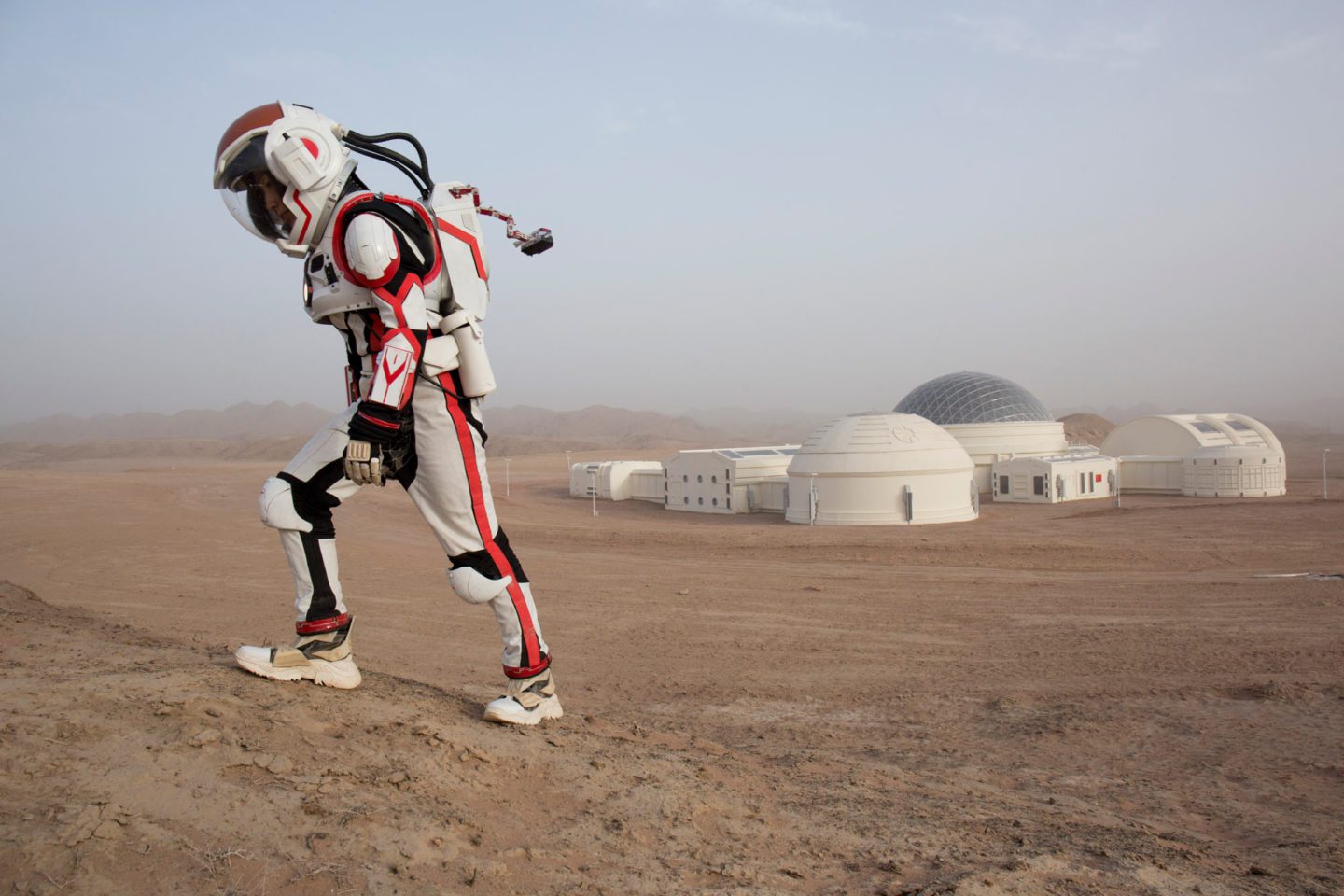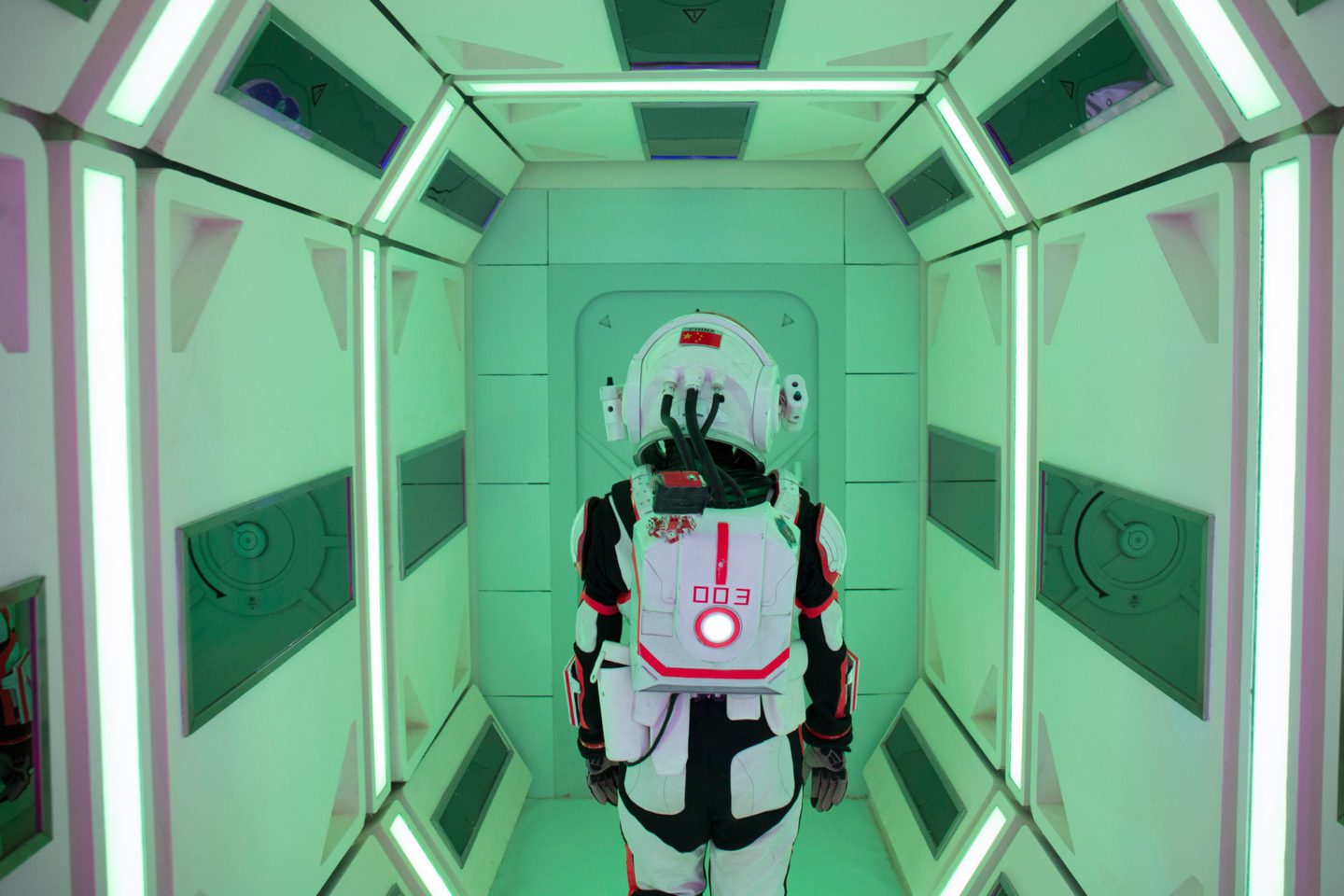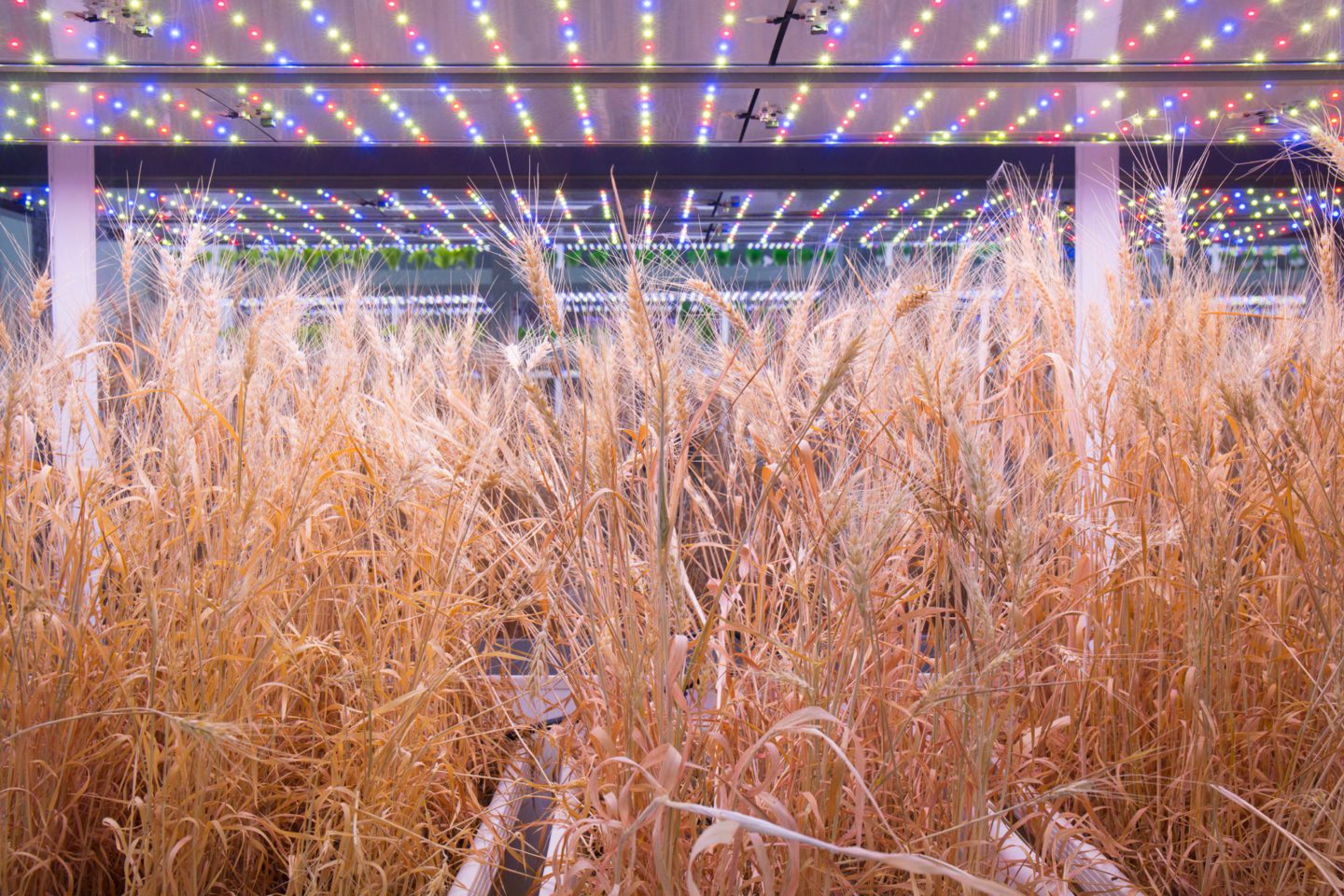In 1932, the Chinese writer Lao She serialised a book in which the narrator is stranded on Mars after his rocket crash lands there. It’s an extraordinary dystopian narrative, which depicts his encounters with a race of cat-like people who are addicted to ‘reverie leaves’. This addiction, which inspires both crime and moral apathy, lies at the heart of a way of life so decadent that the narrator realises he is witnessing ‘the extinction of a whole civilisation’.

The Chinese flag positioned above an entrance hatch to a Mars simulation base built on the fringes of the Gobi Desert, near Jinchang city in China’s far West Gansu province.
Lao She’s Cat Country was a satire of 1930s China that – through its scenes of casual torture and depiction of an eviscerated education system – devastatingly predicted the worst excesses of Mao’s Cultural Revolution. Yet it is also the earliest example of sophisticated Chinese science fiction, taking place against the backdrop of a planet where lightning flashes red and raindrops as large as eggs fall from the sky. In an early evocation of the alien atmosphere he writes, ‘A model for this universe would be a bean curd parlour back home filled with hot fumes in the night, lit by a single oil lamp scattering rays of ghastly light through the mist’.
A little later when he sees his first cat person he observes, ‘Apparently time had no value here, for it seemed as though several centuries passed before he got very close to me’.

China is playing catch-up with interplanetary exploration but in 2018 sent more rockets into space than any other nation.
Almost ninety years later, it seems possible that China could be the first country to genuinely land humans on Mars. Though NASA currently leads the way in exploration of the red planet, this October China unveiled pictures of its own Mars rover – which will launch in 2020 – and in November revealed its long-term plans to send taikonauts. After several decades of playing catch-up, the sophistication of China’s space program as a whole was confirmed when its robotic probe Chang’e 4 made history by landing on the dark side of the moon on January 3 this year.
As Brian Harvey, author of China In Space: The Great Leap Forward says, ‘It was a tipping point – they achieved something that no other country had done, and it also marked out their technology as being very very sophisticated. As we know, the far side of the moon is never visible on earth, so they had to put a relay satellite into orbit behind and above the moon so that it had the lander and rover constantly in sight and was able to transmit the pictures from each back to earth. They were also in command of the situation when the landing took place. It was a moment that made all the other countries sit up and watch’.
‘China sees itself as a great and ancient civilisation that was practising astronomy and science from before 2000BC.’
Brian Harvey, author of China In Space: The Great Leap Forward
Harvey emphasises how dramatic an advance it was from when the Chinese Space Program launched in 1958. ‘China sees itself as a great and ancient civilisation that was practising astronomy and science from before 2000BC,’ he says. ‘It then endured the century of humiliation [from 1839 to 1949, when both Western powers and the Japanese invaded and took control at different points along the east coast]. Now they are recovering their great scientific tradition. However, at the time the space program started, the most advanced technology in the country was diesel engines for trucks. Most people went about their work by bicycle. Even in the 1970s when they began their manned space program they practised on wood and cardboard mock-ups of spacecraft. This is something that they really really want to leave behind them.’

The base is a close approximation of the environment on Mars and is used for the purposes of education and entertainment.
The 2015 Ridley Scott movie The Martian famously shows the Chinese National Space Administration stepping in to save Matt Damon’s ass – and by implication NASA’s – when it launches a classified booster rocket to take fresh supplies to the astronauts who will rescue him. Politically such a collaboration would be impossible, not least due to a US law passed in 2011 explicitly banning cooperation between America’s state-run space program and China’s. Yet beyond ensuring valuable Chinese box office (the movie made £33.3 million there in its first week alone) it was also an acknowledgement from the US of China as a space technology equal. Denis Villeneuve’s sci-fi hit Arrival, released a year later, similarly featured an ultimately positive collaboration between the Americans and the Chinese.
So when was the crucial turning point for the Chinese Space Program? According to Andy Thomas, who has just completed a PhD titled The Chinese Space Program in the Popular Narrative of Space, it came in 1978. ‘Deng Xiaoping was welcomed in America by Jimmy Carter,’ he explains, ‘and he was taken on a tour of NASA facilities in Houston. He was welcomed into the Johnson Space Center in Houston Texas and was given the stick of the space shuttle simulator so he could do a simulated landing. When he emerged, he realised that China had to modernise to maintain their place in the world. The whole story of China in space since then has been about modernisation and reform. They are using technology and science in that order to reform their society.’

China does not have a big space budget compared to the US; recent estimates put it at £6.5 billion compared to £37 billion per year. Its strength comes in its consistency.
Yet as China increasingly asserts itself as a superpower in space, surely this is about more than the modernisation of its own society. As well as launching its Mars rover in 2020, it is going to be testing one of its impressive new generation of rockets, the Long March 5B-carrier rocket in preparation for launching the Tiangong Space Station which should be completed in 2022. In recent years it has sent more rockets than any other nation into orbit, has opened the gleaming Wenchang Spacecraft Launch Site in Hainan province, and has constructed the world’s largest single-dish radio telescope. The opening of the £5.73 million China Mars Base in the Gobi desert earlier this year – both as an educational facility and as a place where tourists are invited to come and learn about China’s Mars exploration ambitions – is a more light-hearted manifestation of its ever growing ambitions.
Harvey praises in particular the increasing precision of China’s technological innovations. ‘Last year the Chinese set up the first quantum link between communication satellites around the earth on a link between China and Austria. It works through quantum entanglement which means you can beam messages up to a satellite and back down again in a way that is completely unhackable. This is very much post Stephen Hawking-type science.’

The Gansu base seen from overhead.

Crops under lights
Are we witnessing a space race between China and the US? Thomas thinks not. Denouncing the term ‘space race’ as a ‘super saturated signifier’ he says, ‘If you were part of the US defence administration you would probably call it that, but it’s important to look from a broader perspective’. Harvey agrees. ‘The US and especially Vice President Mike Pence see the US as racing against China, not least in getting back to the moon before they land there. But their planning horizons are very different. I’ve written a lot about the Roadmap 2050 developed by the Academy of Sciences for China’s future role in the exploration of space. This does mean going to the moon in the 2030s and Mars in the 2040s, but to answer your question very directly I don’t think they see it as a race. Its program is slow and deliberate and so far accords with the 50-year roadmap. A better analogy might be the hare and the tortoise – though of course it is the tortoise who wins in the end.’
A Pentagon report from just last year asserted that Chinese strategists see the ability to use space-based systems as ‘central to modern warfare’.
China does not have a big space budget compared to the US; recent estimates put it at £6.5 billion compared to £37 billion per year. Its strength comes in its consistency – in contrast to NASA, once the money has been pledged it is guaranteed and projects are not changed from year to year according to the whims of any President. Even so, the size of the budget seems to support both Thomas and Harvey’s judgement that the China’s space program is essentially just one aspect of its pursuit of scientific excellence. ‘One particular Chinese objective was to achieve the largest number of scientific papers to be published in the world, more than any other country by 2050,’ declares Harvey. ‘And there’s a real problem with that target in that they achieved it two years ago.’
Thomas has travelled extensively through China for his PhD research, most recently from Beijing to Huludao on the south coast where Yang Liwei, China’s first astronaut was born. ‘There’s a massive statue to him in his home town,’ says Thomas. The trip also took him to Guangzhou and then to Zhuhai for the annual air show, before he went down into Hong Kong. As well as observing the general enthusiasm for the scientific and technological aspects of the space program, he is convinced that the main Chinese aim is to foster international collaboration. He predicts that it won’t be long before ‘the new Chinese space station eventually takes over from the International Space Station’ which will lead to a ‘joint exploration of space’.


Yet what about the military implications of China’s space program, and repeated warnings from the US about the dangers of how it could deploy its new technologies. A Pentagon report from just last year asserted that whatever its public statements are to the contrary, Chinese strategists see the ability to use space-based systems as ‘central to modern warfare’. It talked about counterspace weapons that include kinetic-kill missiles, ground-based lasers and orbiting space robots. It also warned about the increasing sophistication of surveillance capabilities that can monitor objects across the globe.

‘Martian Spuds’ containers: Potatoes kept in jars at the C-Space Project Mars simulation base. Matt Damon’s character Mark Watney famously grew potatoes on Mars in 2015 film The Martian.
Thomas declares, ‘There’s a crossover in all nations’. Which is of course true. From declassified CIA papers of the 1960s showing US interest in creating a military lunar base to Russia’s overt merging of its space and air defence forces in 2015, both the technologies and the imperial ambition inherent in space exploration have a long-term overlap with defence interests. The extent to which this is allowed to eclipse more positive aspects is going to be defined by geostrategic relationships. For instance, China is already collaborating with the European Space Agency. But it seems it will take several light years and a dramatic shift in the balance of world power for the US to contemplate the same.
In the meanwhile, Harvey thinks that it’s important to watch Chinese progress in space over the next couple of years to judge whether or not their ambitions of putting humans on Mars will be realised on time. ‘The real test of China’s progress to a Mars base is first of all going to be how things go with the launch of their unmanned spacecraft towards Mars next year. They are planning a sample return late in the 2020s for which they will need the Long March 9 rocket [a super heavy-lift carrier rocket, which is still in development, and will be the most powerful rocket in the world]. Beyond this, they have to develop all the technologies that they’re going to need for a Mars landing and a Mars base. They will of course have thought through in a lot of detail not just how are we going to get there, but what kind of technologies do we need to master?’


The base is also occasionally used for entertainment purposes, including a recent Big Brother-style celebrity reality TV show, by Internet TV giant Youku.
Thomas is sceptical that any country is going to be able to put humans on Mars for any significant duration because of the radiation levels. In just getting to Mars, an astronaut would be exposed to 15 times the annual radiation limit for someone working in a nuclear power plant. ‘It’s not just a question of technological advance, we’re talking questions of social responsibility and morality,’ he says.
‘I think it’s more significant to look at China’s plans for a base on the moon,’ he continues. The timeline for this has not been announced for this yet. ‘But I think this will be really significant.’ Almost as significant as the other scenario he suggests. ‘Maybe by that time they’ll be collaborating with NASA.
More from Jonathan Browning










